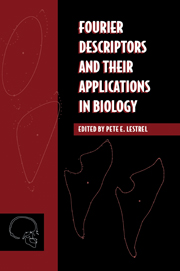Book contents
- Frontmatter
- Contents
- List of contributors
- Preface
- Acknowledgments
- Part one Theoretical considerations
- Part two Applications of Fourier descriptors
- 6 Closed-form Fourier analysis: A procedure for extraction of ecological information about foraminiferal test morphology
- 7 Fourier descriptors and shape differences: Studies on the upper vertebral column of the mouse
- 8 Application of the Fourier method on genetic studies of dentofacial morphology
- 9 Fourier analysis of size and shape changes in the Japanese skull
- 10 Craniofacial variability in the hominoidea
- 11 Heuristic adequacy of Fourier descriptors: Methodologic aspects and applications in Morphological
- 12 Analyzing human gait with Fourier descriptors
- 13 Elliptic Fourier descriptors of cell and nuclear shapes
- 14 Cranial base changes in shunt-treated hydrocephalics: Fourier descriptors
- 15 A numerical and visual approach for measuring the effects of functional appliance therapy: Fourier descriptors
- 16 Size and shape of the rabbit orbit: 3-D Fourier descriptors
- 17 From optical to computational Fourier transforms: The natural history of an investigation of the cancellous structure of bone
- 18 Epilogue: Fourier methods and shape analysis
- Appendix
- Glossary
- Index
12 - Analyzing human gait with Fourier descriptors
Published online by Cambridge University Press: 14 September 2009
- Frontmatter
- Contents
- List of contributors
- Preface
- Acknowledgments
- Part one Theoretical considerations
- Part two Applications of Fourier descriptors
- 6 Closed-form Fourier analysis: A procedure for extraction of ecological information about foraminiferal test morphology
- 7 Fourier descriptors and shape differences: Studies on the upper vertebral column of the mouse
- 8 Application of the Fourier method on genetic studies of dentofacial morphology
- 9 Fourier analysis of size and shape changes in the Japanese skull
- 10 Craniofacial variability in the hominoidea
- 11 Heuristic adequacy of Fourier descriptors: Methodologic aspects and applications in Morphological
- 12 Analyzing human gait with Fourier descriptors
- 13 Elliptic Fourier descriptors of cell and nuclear shapes
- 14 Cranial base changes in shunt-treated hydrocephalics: Fourier descriptors
- 15 A numerical and visual approach for measuring the effects of functional appliance therapy: Fourier descriptors
- 16 Size and shape of the rabbit orbit: 3-D Fourier descriptors
- 17 From optical to computational Fourier transforms: The natural history of an investigation of the cancellous structure of bone
- 18 Epilogue: Fourier methods and shape analysis
- Appendix
- Glossary
- Index
Summary
Walking and Fourier analysis
One of the distinct human characteristics is bipedalism. This means of locomotion has existed throughout human history for more than three and a half million years ago judging from the fossilized footprints at Laetoli in northern Tanzania (Leakey, 1987). Scholars throughout the world have long been interested in human bipedal locomotion and have attempted to analyze it by various means.
Dimensional measurements
To understand the nature of human locomotion, we must recognize that the walking cycle which is composed of dimensional and temporal measurements. Figure 12.1 illustrates the components making up the walking cycle. These dimensional measurements are composed of both right and left step lengths, foot angles, and step widths. A step length is defined as the distance from one heel point to the other; for example, the right step length is expressed as the distance from the left heel point to the right heel point. Foot angle is defined as the angle of a foot from a center line drawn between both feet. Step width is the distance between right and left heel points normal to the center line.
Temporal measurements
Walking is the repeated alternation of one leg followed by the other, with one limb remaining in contact with the ground.
- Type
- Chapter
- Information
- Fourier Descriptors and their Applications in Biology , pp. 294 - 306Publisher: Cambridge University PressPrint publication year: 1997



